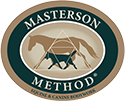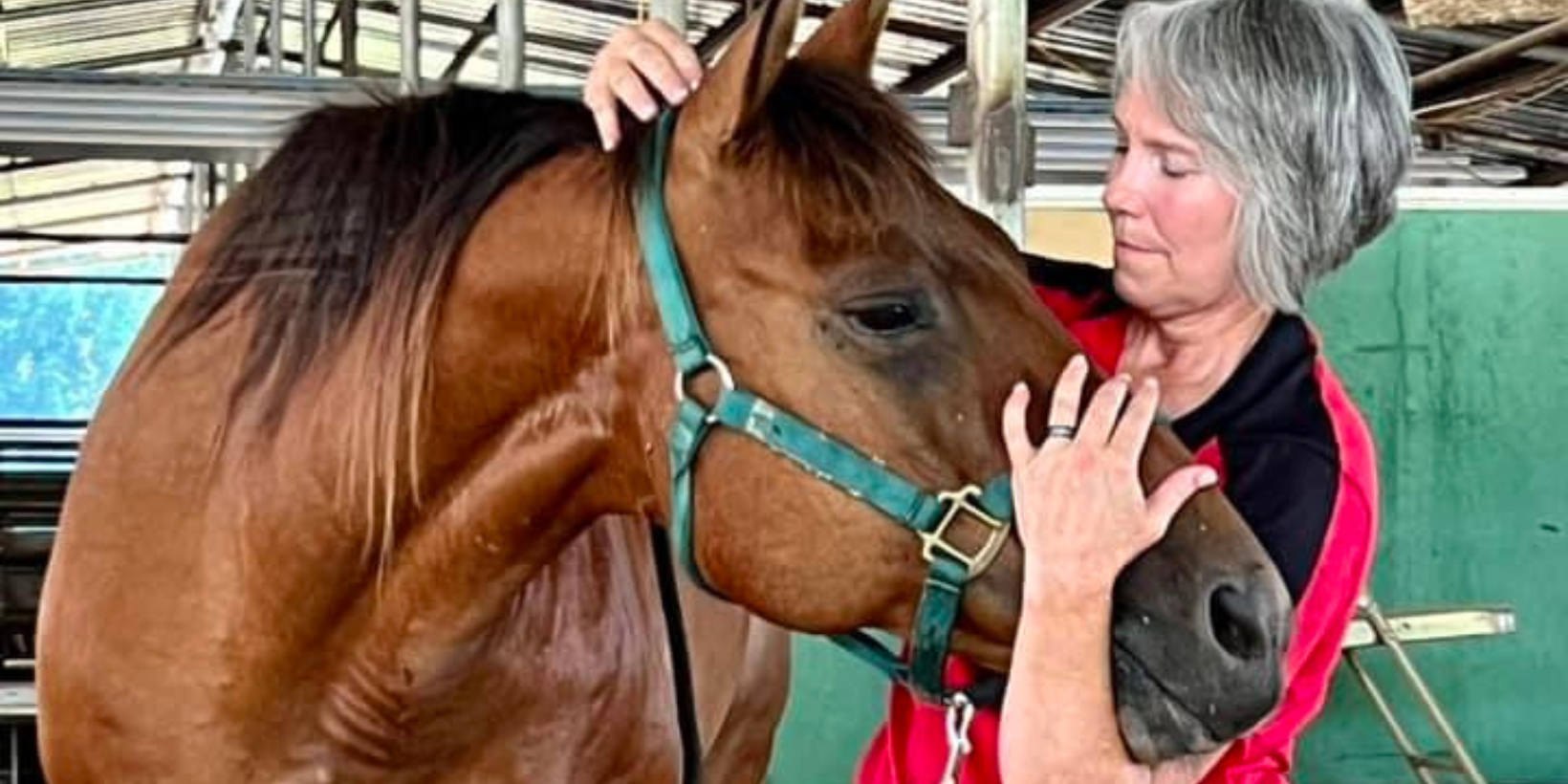by Alice Long
This is a beautiful story of a herd that was changed through the wonderful work of students who attended The Masterson Method Equine Specialist (MMES) course and a little horse named “Flash” who was not trusting of humans at all, except for his “boy” that apparently had a special place in this horse’s heart. More about that in a bit!
Last month, I had the opportunity to instruct the MMES course held at Equestrian Zone (EZ) in Dardanelle, Arkansas. The mission of Equestrian Zone is “To enrich the lives of persons with special needs/disabilities and foster functional independence with increased self-confidence and improved skills of daily living through the use of safe and enjoyable adaptive, equine-assisted activities”. We often hear how the use of The Masterson Method® in such programs improves the lives of people, but we also must continue to shine a light on how it helps improve the lives of the horses as well!
The minute I arrived at EZ, I could feel the atmosphere of this place as very calm, hospitable, welcoming, and a place of acceptance. I was able to meet with the people and horses of the program before the course started. Obviously, the horses are very well cared for and are and are an extremely valuable asset to this program and are truly appreciated by the staff and volunteers.
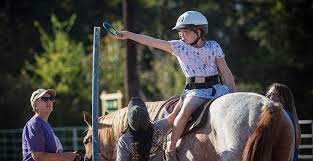 Horses that work in these types of programs are required to participate in numerous activities with various types of people, whose needs may differ greatly. The horses are expected to adapt to any given situation and give full of themselves to help create a safe space for the people who participate in these programs. Not only are the horses required to give of themselves physically but emotionally as well.
Horses that work in these types of programs are required to participate in numerous activities with various types of people, whose needs may differ greatly. The horses are expected to adapt to any given situation and give full of themselves to help create a safe space for the people who participate in these programs. Not only are the horses required to give of themselves physically but emotionally as well.
Many people like to “donate” their horse to Equine Assisted Activities as a “retirement” job, some thinking it’s a very easy life for the horse. But being such an important part of these programs does take quite a bit of time and energy from the horse. This is the reason that it’s so imperative for their caregivers to provide anything and everything the horse may need to be successful in their jobs.
Utilizing The Masterson Method in such programs is one of many things we can do to provide a wellness plan for the horses, specifically The Masterson Method Equine Specialist course. As the creator of The Masterson Method, Jim Masterson states, “It’s a win/win for horse and human”. As the participants perform a very simple, yet very effective Masterson Method technique, not only does the horse benefit but so do the participants. And it truly is a “win/win”! There is “proof in the pudding”!
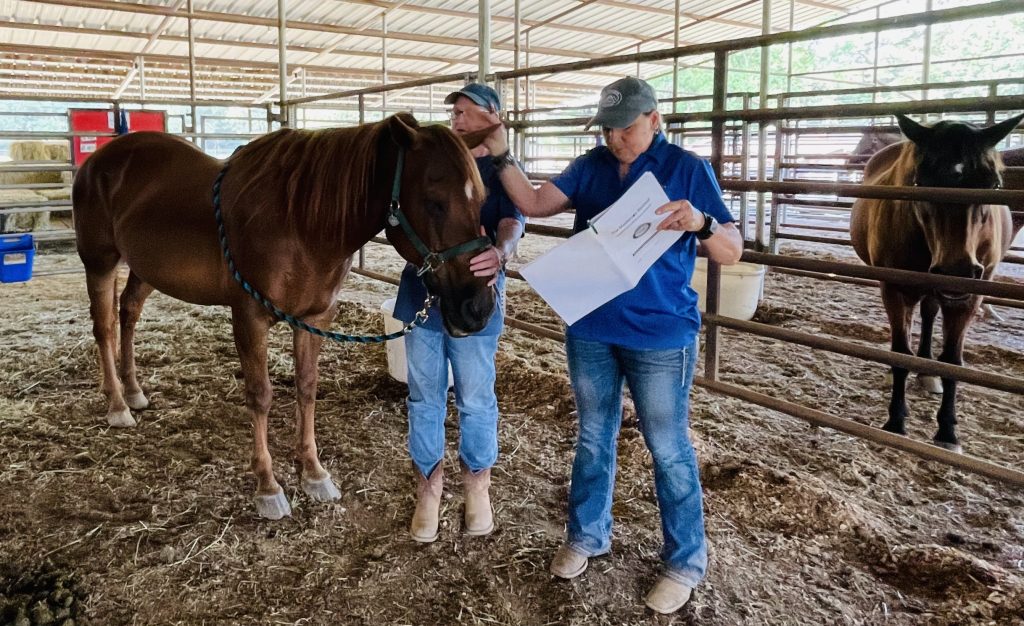 The students in this course are what makes it so successful for the horses! As they learn how to implement The Masterson Method into their program, the participants benefit while learning how to help the horse release deep-seated tension, both physically and emotionally. Doing so allows the horse to feel its best when partnering with human participants in the program. Many horses get “burned out” in this work, due to physical and/or emotional strain that this type of work may create. Horses in Equine Assisted Activities/Therapy are truly the hardest-working horses in the business!
The students in this course are what makes it so successful for the horses! As they learn how to implement The Masterson Method into their program, the participants benefit while learning how to help the horse release deep-seated tension, both physically and emotionally. Doing so allows the horse to feel its best when partnering with human participants in the program. Many horses get “burned out” in this work, due to physical and/or emotional strain that this type of work may create. Horses in Equine Assisted Activities/Therapy are truly the hardest-working horses in the business!
Back to Flash! On the day that arrived, I was evaluating the horses with the program’s Executive Director, Therapeutic Riding Instructor and Barn Manager, Connie Holt. Connie’s heart for this work is second to none! Connie not only introduced me to the entire herd that would be participating but also to a little guy named Flash whom she said would not be a good participant in the course.
Connie explained to me that Flash belonged to her young grandson and that he was the only one that Flash would interact with in a safe manner. Flash would go to the back of his large stall anytime anyone would come near. He was super shy, a bit flighty and he wasn’t the type of horse that just anyone could work with. In fact, the volunteers of the program did not trust Flash for this work and would prefer to not work with him.
Flash was also well known for running from staff and volunteers out on the pasture and for literally bolting through the gate as soon as it was opened and not stopping until he made it to the barn. It wasn’t safe for people to lead him to the barn. Flash was very protective of the poll and his hind end. He didn’t want people anywhere near those areas.
After conversing with Connie about Flash, I entered his stall and just gave him a few minutes to accept my presence. I then introduced myself to him with a little “Bladder Meridian” and shortly had his halter on and I went through my typical “evaluation” to ascertain whether he would be a good participant for the course. Once I came out of his stall, I asked Connie if she was okay with me partnering with Flash as the “full demo horse”. Meaning, I felt he may not be an ideal participant for students, but I felt he’d make a great demo horse, as my hopes were that by allowing Flash to have a full bodywork session the students would be able to see the subtle improvements and changes in him as I worked. Though he wouldn’t let me touch his hind end during the very short eval, I wanted to afford him the chance to trust.

As I worked with Flash for the demo, it was obvious to the students that he was in fact releasing deep-seated tension in his body by observing his twitches, fidgets, licks, chews, yawns, zoning out and letting me touch his poll and hind end! I was super pleased with his participation in his session and that he was feeling better. It was, to me, a typical bodywork session (if there really is such a thing!). The course went off without a hitch and the students were super impressed with the work they accomplished with this lovely herd. They worked beautifully in pairs, as they assisted the horses in their first-ever experience with this form of bodywork! It was so rewarding and fun to watch!
The next morning, I was very excited to have received pictures and texts from Connie about Flash! When I made it out to the barn, I had a conversation about the changes Connie observed in Flash! Connie explained that when she brings the herd up in the mornings, she just opens the gate and gets out of Flash’s way, so as not to get trampled and that nobody can touch him in the pasture. The only way to touch him is in his stall and that’s if you can get his halter on.
She explained that when she went to bring him up from his pasture for breakfast the next morning after his session, she opened the gate and Flash just stood there. Not only did Flash just stand there relaxed, but Connie was also able to pet him all over his body and he enjoyed it! When she was done petting him, which was a HUGE deal, Connie began taking the long walk back to the barn. To her surprise, Flash, at liberty, began to follow her. He never ran ahead. He stayed right behind her with his head low and followed her at a slow walk all the way back to the barn!
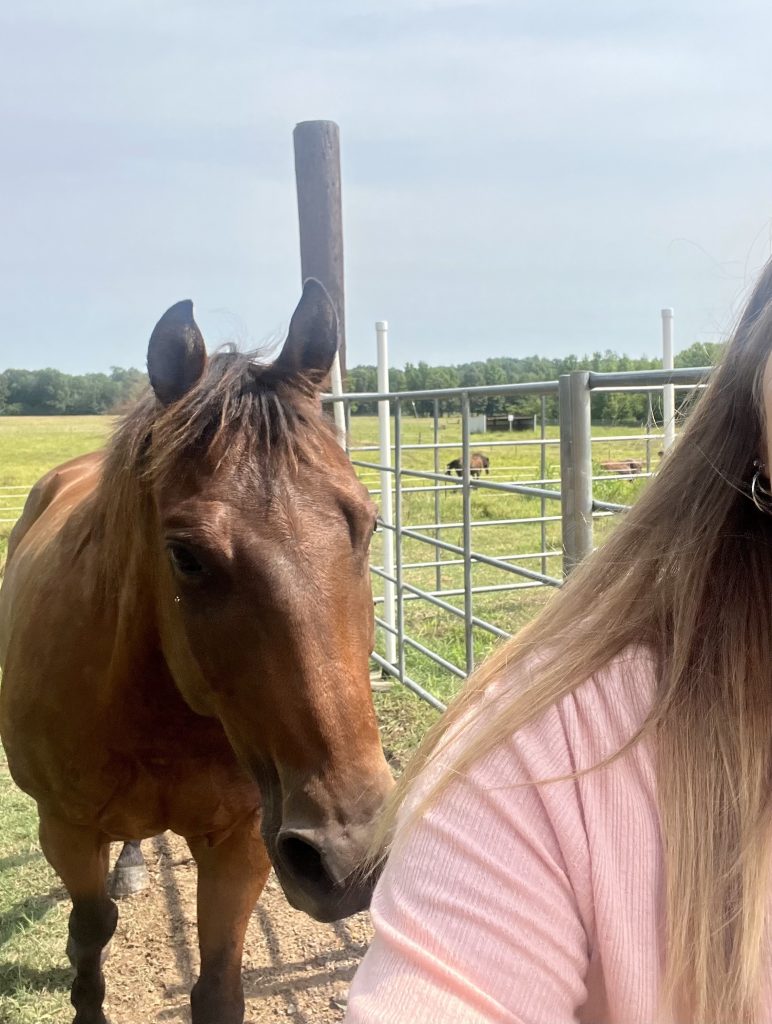
To test the theory, the next day Connie had a volunteer walk down to his pasture to see how Flash would respond. You guessed it! He followed the volunteer in the same relaxed manner as the day before. Connie also reported that Flash no longer hides in the back of his stall and even accepts treats from everyone at the front of his stall. Several days after I made it back home to Maryland, Connie continued to send me texts and pictures of the wonderful changes, not only in Flash but now the entire herd was waiting for Connie to follow her back up to the barn at liberty!

The changes the students made for this herd were super impressive and I wouldn’t have believed it to this extent had I not seen it for myself. One of my favorite things about this work is that we can never know the full extent of the positive changes that can be made for horses by just helping them feel comfortable in their own bodies. Many times, the tension in the horse’s body can make them feel quite vulnerable, nervous, shy, angry, and even shut down. Facilitating the release of tension for the horse will improve every aspect of their lives!
Thank you to Equestrian Zone and the many other programs that have invited The Masterson Method to be a small part of your mission of creating a happy and healthy environment for horses and humans. I am truly honored and grateful for that.
If you work or volunteer in such programs, I highly encourage you to attend or host this course to help improve the lives of horses and humans who work and benefit from these much-needed programs. Below is a link to courses that are currently being offered.
Find more information on The Masterson Method Equine Specialist Courses here.
Here’s the letter we received from Connie Holt with the testimonial of this story:
“May 1st, 2021 my husband and I took our grandson to a ranch in Tulsa, Oklahoma where they specialize in matching up roping horses and riders for my grandson was 10 and just starting to rope. When we got to the barn the owner had 21 horses tied up in the alley, he told Keylen to walk around, get to know a few, and see who speaks to him. Keylen did just that, taking his time but kept going back to this one little bay.
The owner gave us his history, he was bought from a working ranch in Texas and had arrived at this barn two weeks prior. They saddled him up and Keylen rode him around for about half an hour then the roping began. Keylen was a beginner but this little horse got Keylen right where he needed to be every time it was his turn. The owner told Keylen to pick out another horse to try a few different horses. Keylen tied up the bay and as he was looking at the other horses, the bay untied himself and when Keylen turned around there the bay had his nose in his face.
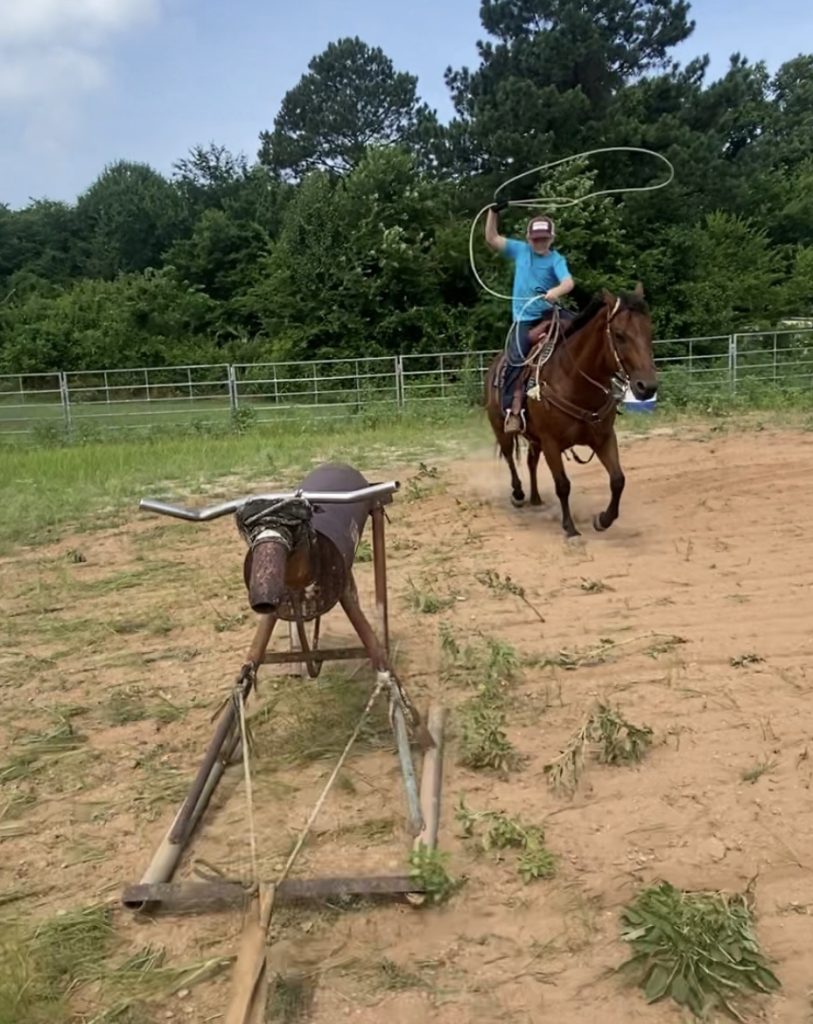
Well, Keylen did not ride any other horses that day. The next morning the little bay was in his stall and pretty spooky. He backed away from me and was snorting but when Keylen walked into the stall, he went right up to him, put the halter on, saddled him up, then rode him most of the day. Although I had my reservations about him, we came home with that bay.
Two years later Flash is still very spooky, not wanting anyone on his right side. He would literally go in a circle to prevent anyone from that side, and I don’t know why! Even to use fly spray he is still snorty and will go to the back of the stall when anyone would enter. The second a lead rope was placed on his neck he would put his head in the halter. After last year’s rodeo season, I brought Flash to work with me so that I could mess with him every day.
In the winter I was feeding in the pastures, and he would not let me near him. I started making him go up to the barn before he got fed. His pasture is on the far side of the arena, I would open his gate and he would bolt out of the gate and in a dead run, bucking, kicking all the way around the arena up the hill to the barn and he would be in his stall eating when I got up there. -I know that is not a good habit – but He wouldn’t come to me at the gate……
When Alice arrived for the MMES training at my facility, she asked me who of all of my horses did I think would not be a good fit for the training. I told her of two, Chakota a mustang that will not tie up and keeps her head high, and Flash, so timid and spooky that volunteers will not even go into his stall to clean it or lead him back to his pasture. He would not even come to the gate for carrots from anyone. He was doing better with me but still had his moments.
Later that day Alice asked me if she could use Flash for the demo. I said sure if that’s what you want to do. My husband happened to be here-typical skeptical, cowboy that said, “Well if there is anything to any of this, she picked the right horse to prove it.” She spent some time with him in the stall then when it came time for the demo, she brought him in where all of us students were and worked with him for over two hours. I was amazed as to how he worked with her, watching for his reactions was so clear, even when he didn’t understand what was happening and backed away from her, she stayed with him. During that session, Flash had gotten so relaxed he pooped twice and urinated twice. His responses and releases were so evident, we should have recorded the entire session.
On Saturday I was getting the horses up for the last day of the training. I had everyone’s feed waiting in their stalls and my friend, was in the area ready to close stall doors as the horses filed in. I had told her if Flash saw her he would not go to his stall. I went down and opened his gate for him to go to the barn and he walked out of his pasture, stopped, and looked back at me. When I closed the gate I turned to him, in shock, he was just standing there I said “Oh, Hi Flash” and walked to him. I rubbed him on BOTH sides then I turned to walk around the arena and up the hill to the barn. Flash followed right behind me, never tried to run around, I walked him all the way to his stall.
Four days later Keylen came for a few days, and I told him about it. I knew he didn’t believe me, I sent him down to let Flash out. When Keylen opened the gate, he kept the gate between him and Flash expecting Flash to bolt out ripping and roaring. Flash just walked out and stopped, looked back, and waited on Keylen. Keylen rubbed on him and then Flash followed him all the way to his stall. As they walked past me in the barn Keylen said “Well GIGI, I will take it!”
It has been two weeks since the training. Flash still follows whoever opens his gate, now it doesn’t even matter if it’s a volunteer. While in his stall he now comes to the gate for carrots, or just attention from someone asking him to come closer. He is no longer kiddish about his right side; he allows fly spray and the volunteers are no longer avoiding his stall.
I can NOT explain what happened, or how, all I know is SOMETHING did happen and he is a much more settled, trusting, relaxed horse and it is an absolutely wonderful, amazing thing. I can tell a huge difference in all the horses in my herd but not as significant as Flash.”
Connie Holt, Executive Director of Equestrian Zone
